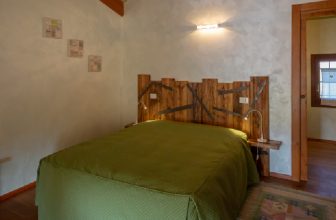How to Decorate With Rocks
Decorating with rocks is a timeless and versatile approach to adding natural elements to your interior or exterior spaces. Whether you aim to create a serene Zen garden or a rugged and textured feature wall or simply wish to incorporate subtle earthy tones into your decor, rocks offer a durable, low-maintenance option.
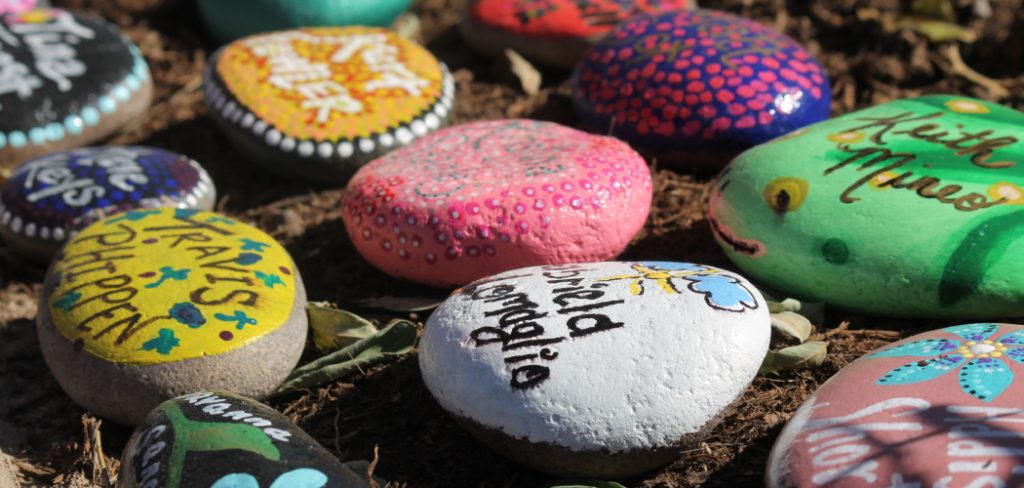
This guide on how to decorate with rocks explores various creative ways to adorn your living or working spaces with rocks. From selecting the right type and color of rocks to match your aesthetic to placement techniques that enhance the overall ambiance, we’ll walk you through how to harness the rustic charm and inherent beauty of natural stone in your decorating projects.
What is a Good Type of Rock to Use for Decoration?
When selecting rocks for decoration, the first thing to consider is the type of rock and its inherent properties. Some popular options include:
Limestone:
This light-colored and porous rock is ideal for creating a textured and rustic look. It is often used in outdoor spaces for pathways, retaining walls, or as accent pieces.
Granite:
Known for its durability and variety of colors, granite can be polished to give a smooth surface or left in its natural state for a more rugged appearance. It is commonly used as countertops, flooring, and as a base for outdoor fire pits.
River Rock:
These smooth and rounded rocks are perfect for creating a peaceful and Zen-like atmosphere. They are often used in indoor fountains or as ground cover in gardens.
Slate:
Slate is a fine-grained rock that comes in various shades of grey, green, and red. It can be split into thin layers, making it a popular choice for wall cladding and decorative accents.

Marble:
Known for its elegant and luxurious appearance, marble is a softer rock that can add sophistication to any space. It is often used as flooring or as a base for sculptures and other decorative pieces.
10 Simple Step-by-step Guidelines on How to Decorate With Rocks
Step 1: Preparing Your Space
Before you start decorating with rocks, it’s important to prepare your space by cleaning and decluttering. This will give you a blank canvas to work with and allow you to visualize the placement of rocks more easily. It’s also a good idea to protect any delicate surfaces or objects in the area. But don’t worry too much about perfection, as the natural and imperfect nature of rocks is part of their charm. The key is to find a balance between incorporating rocks and maintaining the functionality of your space.
Step 2: Choose Your Color Scheme
Rocks come in a wide range of colors, from earthy brown and grey tones to vibrant reds, blues, and greens. It’s important to select rocks that complement your existing color scheme or create a new one. Consider the natural lighting in your space and how different types of rocks may appear in different light conditions. But don’t be afraid to mix and match different colors for a more dynamic look.
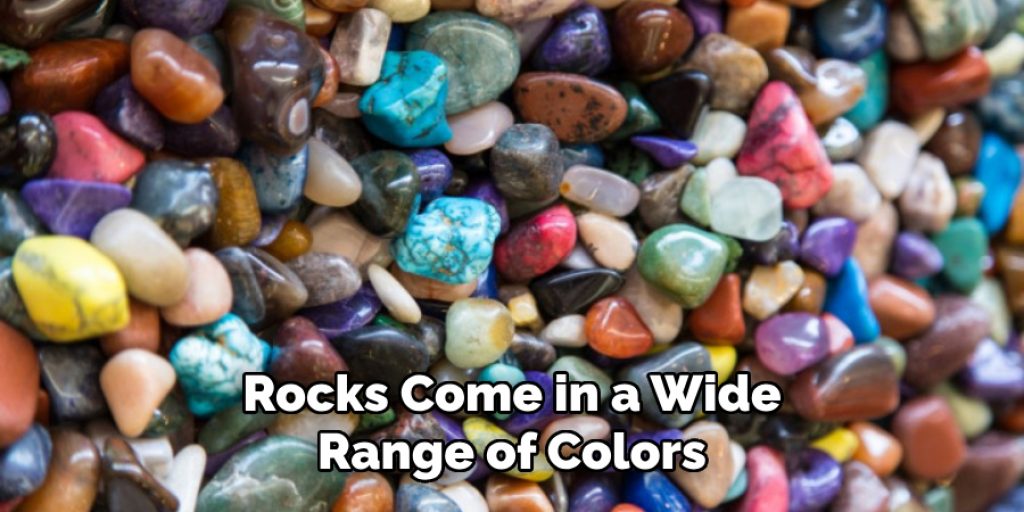
Step 3: Determine the Purpose of Rocks in Your Space
Are you using rocks as a focal point, an accent piece, or for functional purposes? This will help guide your selection and placement of rocks. For example, larger rocks can serve as a centerpiece in a garden or act as a natural barrier for water features. Smaller rocks can be used to fill in gaps or add texture to walls and other surfaces. The purpose of rocks in your space will also influence the type and size of rocks you choose.
Step 4: Consider Size and Shape
Rocks come in all shapes and sizes, so it’s important to think about how they will fit into your space. Larger rocks can make a statement but may also be more challenging to move and place. Smaller rocks can be more versatile and easier to work with but may not have the same impact as larger ones. The shape of rocks can also add interest and variety to your decor. For example, flat and smooth river rocks can be stacked to create a unique wall or sculpture. You can also mix and match different sizes and shapes for added texture.
Step 5: Experiment With Placement
There is no one right way to place rocks in your space. Experiment with different arrangements to find what works best for you. Consider creating patterns, grouping rocks of similar colors or sizes, and incorporating other elements like plants or lighting. Don’t be afraid to try unconventional placements, as long as they are safe and enhance the overall aesthetic. But remember to step back and take breaks throughout the process to assess your progress.
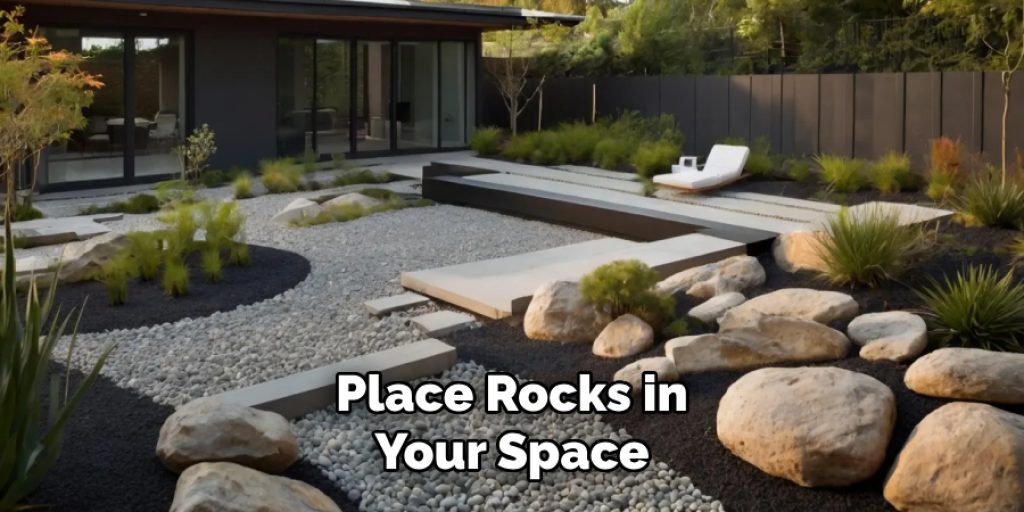
Step 6: Utilize Different Angles
Rocks can look different depending on the angle they are viewed from. Play around with different angles and perspectives to see how the rocks interact with other elements in your space. You may discover new patterns or textures that you didn’t see before. The angle of lighting can also affect the appearance of rocks, so be mindful of how natural and artificial light sources impact your decor.
Step 7: Mix and Match with Other Materials
Rocks can be a versatile and complementary addition to other materials. Consider using rocks alongside wood, metal, or glass to create an interesting contrast of textures and colors. Just make sure to choose materials that blend well together. For example, smooth river rocks can pair nicely with a sleek glass vase or metal sculpture. It’s all about finding the right balance and creating a cohesive look. It’s also a good idea to incorporate natural elements like plants or water features with rocks for a truly organic and harmonious feel.
Step 8: Add Functionality
In addition to their decorative purposes, rocks can also serve functional roles. Use them as stepping stones in a garden path, as bookends for shelves, or even as weights for outdoor furniture during windy days. This adds another dimension to your decor and makes use of rocks in practical ways. You can also incorporate rocks into DIY projects, such as creating a rock garden or building a fire pit. The possibilities are endless! The key is to think outside the box and find creative ways to incorporate rocks into your everyday life.
Step 9: Incorporate Personal Touches
Make your rock decor truly unique by incorporating personal touches. This can be anything from painting or writing on a rock to adding sentimental items like seashells or photos. You can also involve others in the process, such as having children collect rocks and paint them for a family project. These personal touches make your decor more meaningful and add a personal touch to your space. You can also switch out rocks seasonally or for different occasions to keep your decor fresh and interesting.

Step 10: Maintenance
Rocks are low-maintenance, but it’s still important to periodically clean and maintain them. This might include removing debris or dirt from surface crevices, trimming any overgrown plants, and checking for any signs of damage or wear. Regular upkeep will ensure that your rock decor stays looking beautiful and lasts for years to come.
Following these 10 simple steps on how to decorate with rocks will help you successfully decorate with rocks in your space. Whether you’re looking to add a touch of nature or make a bold statement, incorporating rocks into your decor can add texture, color, and personality to any room. So go ahead and start experimenting with this versatile and timeless element today!
Additional Tips and Ideas
- Consider incorporating rocks with different textures, such as rough granite or smooth river rocks, for added visual interest.
- Use rocks in unexpected ways, such as using them as door stops or paperweights.
- Mix and match rocks of different sizes and shapes for a more dynamic look.
- Create a rock garden or use rocks as edging for flower beds.
- Use rocks as a base for indoor plants to create a natural, earthy display.
- Don’t be afraid to mix in other natural elements with your rock decor, such as wood or plants.
- Consider using rocks as a backdrop for artwork or photographs on walls.
- Use rocks as coasters for drinks or as trivets for hot dishes.
- Create a meditation corner with rocks and candles to promote relaxation and mindfulness.
- Incorporate healing crystals into your rock decor for added wellness benefits.
- Don’t limit yourself to just one type of rock – mix and match different colors, textures, and types for a more eclectic look.
- Consider using rocks from meaningful places or trips as part of your decor to add a personal touch. Overall, have fun decorating with rocks and let your creativity guide you! So go ahead and start incorporating rocks into your decor today for a unique and visually appealing space. Happy decorating!
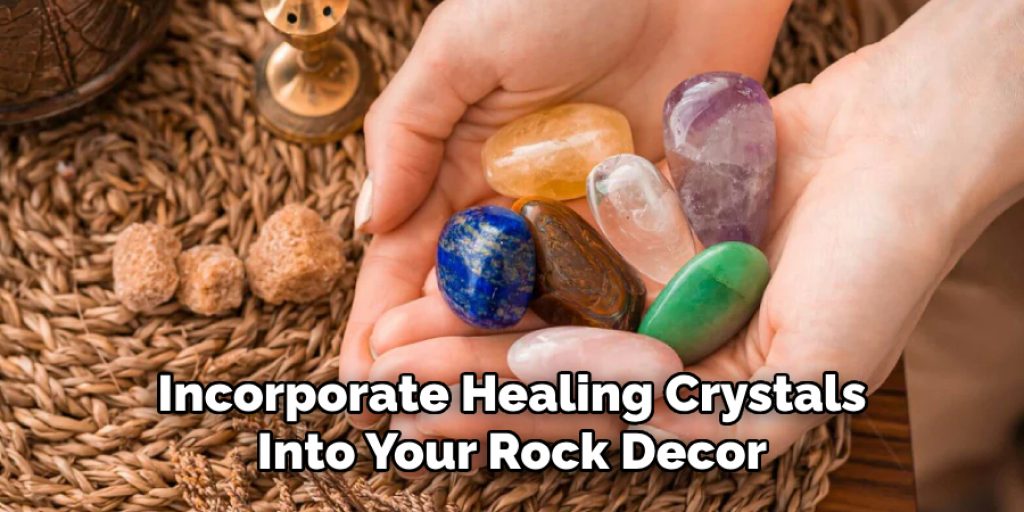
Do You Need to Use Professionals?
Whether or not you need to use professionals to incorporate rocks into your decor ultimately depends on the scale and complexity of your project. If you’re planning on a small rock garden in your backyard, it can likely be done as a DIY project. But if you’re looking to create a larger and more intricate rock feature, such as a waterfall or retaining wall, it may be best to consult with professionals for safety and structural purposes.
Additionally, if you’re not confident in your abilities or have limited experience working with rocks, it may be worthwhile to hire professionals to ensure the job is done properly. Ultimately, it’s important to assess your own skills and comfort level before deciding whether or not to use professionals.
If you do decide to hire professionals, make sure to research and choose reputable and experienced companies or individuals. You can also ask for references and view their past work to ensure they will be able to bring your vision to life. And remember, communication is key – be clear about your expectations and budget from the beginning to avoid any misunderstandings or issues later on.
How Much Will It Cost?
The cost of incorporating rocks into your decor can vary greatly depending on the type, size, and quantity of rocks used. It’s important to consider not just the cost of the rocks themselves but also any additional materials or labor that may be needed for installation. For small DIY projects, you can likely find affordable options at home improvement stores or through online retailers.
However, for larger and more complex projects, it may be necessary to get quotes from professionals to determine the cost. Remember to also factor in any ongoing maintenance costs as well. Overall, incorporating rocks into your decor can range from being a budget-friendly option to a significant investment, so it’s important to plan and budget accordingly.
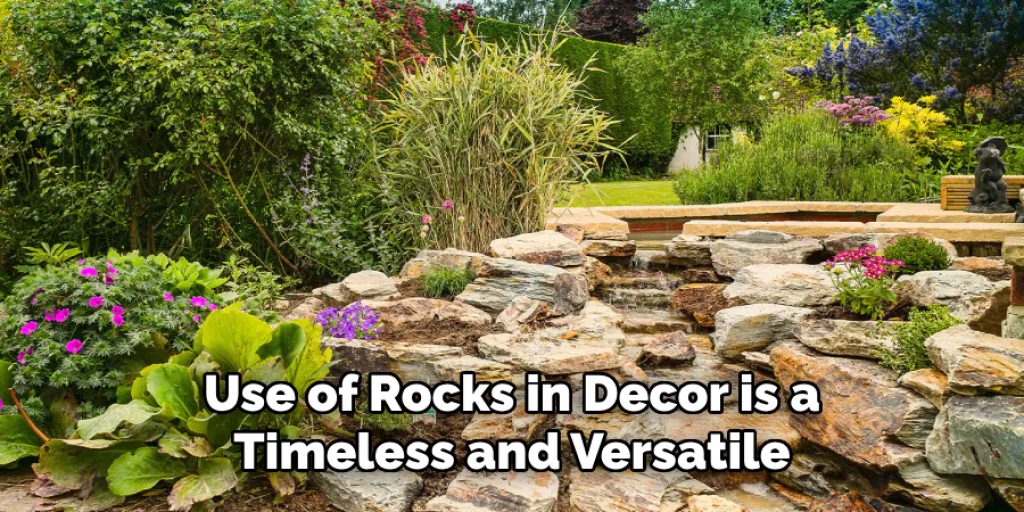
The use of rocks in decor is a timeless and versatile choice that can add an element of nature and uniqueness to any space. Whether you’re looking to make a bold statement or add subtle touches, following these steps and tips will help you successfully incorporate rocks into your decor in a way that suits your style and budget.
Maintenance and Care of Rock Decor
- Keep rocks clean by wiping them down with a damp cloth periodically. Avoid using harsh chemicals or cleaners that may damage the surface of the rocks.
- For outdoor rock decor, check for any signs of weathering or erosion and replace as necessary.
- If you have pets, make sure to secure any loose rocks to avoid accidents.
- Check for potential safety hazards when placing rocks in high-traffic areas, such as walkways or play areas.
- When using rocks for functional purposes, make sure they are securely placed and can bear the weight or pressure of their intended use.
- If incorporating plants with your rock decor, regularly prune and maintain to prevent overgrowth around the rocks.
- Monitor for any signs of mold or mildew growth on rocks placed in damp or humid areas.
- Avoid stacking heavy rocks on top of each other, as this can create instability and potential safety hazards.
- Keep an eye out for any signs of wear or damage to your rock decor and replace them if necessary to maintain their aesthetics and functionality.
- Remember to periodically assess your rock decor and make any necessary changes or adjustments to keep it looking visually appealing and safe.
Frequently Asked Questions
Q: Can I Use Any Type of Rock for Decor?
A: Yes, you can use a variety of rocks for decor, but make sure to choose ones that are durable and suitable for their intended use. For example, smooth river rocks are great for indoor decor, while rougher granite or lava rocks may be better suited for outdoor use. It’s also important to consider the color, texture, and shape of the rocks to ensure they fit with your overall design aesthetic.
Q: Are There Any Safety Concerns When Using Rocks for Decor?
A: Yes, there can be safety concerns when using rocks for decor. Make sure to securely place any loose or heavy rocks to avoid accidents. Also, regularly check for any signs of wear or damage on the rocks and replace them if necessary. It’s also important to assess potential safety hazards, such as rocks in high-traffic areas or sharp edges, and make adjustments accordingly.
Q: Can I Incorporate Rocks into Any Style of Decor?
A: Yes, rocks can be incorporated into various styles of decor, from bohemian to modern. It’s all about how you incorporate them and what other elements you pair them with. For a more rustic look, consider incorporating rocks with natural wood or plants. For a sleeker and more contemporary aesthetic, opt for smoother and more uniform-shaped rocks paired with metal accents.
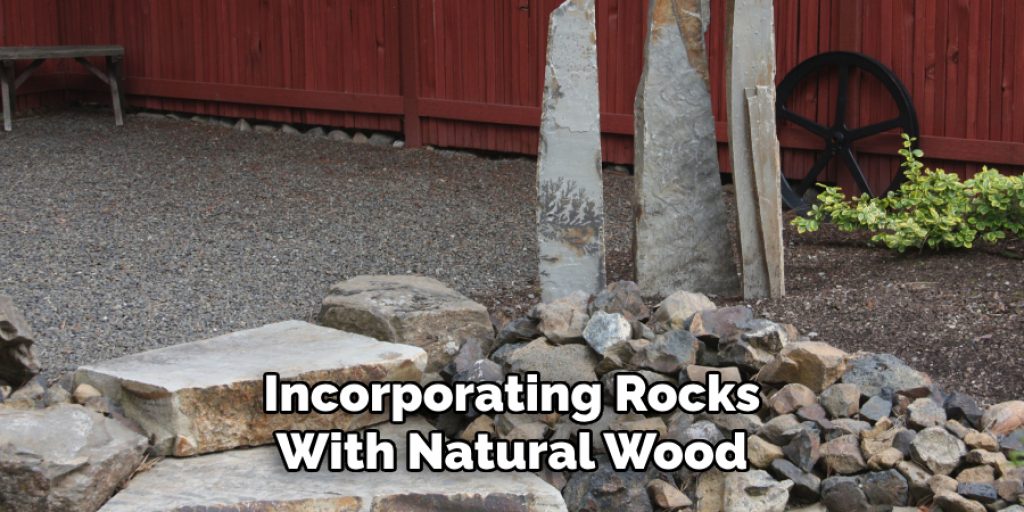
Q: How Can I Make My Rock Decor More Eco-Friendly?
A: To make your rock decor more eco-friendly, consider using rocks that are locally sourced or sustainably harvested. You can also repurpose rocks from your own backyard or from previous landscaping projects. Additionally, you can incorporate plants into your rock decor to create a more natural and environmentally-friendly display.
Q: How Can I Incorporate Rocks into a Small Space?
A: Even in smaller spaces, rocks can be used to add visual interest and texture. Consider using small rocks as bookends or paperweights, or incorporating them into a mini rock garden or terrarium. You can also use rocks as part of a centerpiece on a coffee table or dining table. Just make sure to choose smaller rocks that won’t overwhelm the space. Keep in mind that less can sometimes be more when decorating with rocks in a small space.
Conclusion
Decorating with rocks is a simple yet effective way to add natural elements and personality to your space. Breathe new life into your decor by incorporating rocks in unexpected and creative ways. Remember to periodically assess and maintain your rock decor for both aesthetics and safety. With these tips and ideas, you can create a unique and visually appealing space that reflects your personal style and love for the outdoors.

